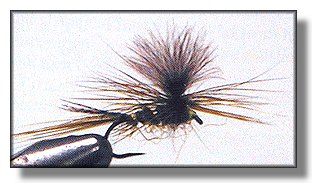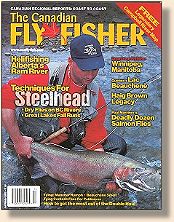
The Dinger
By Chris Marshall
The Dinger is the invention of Peter Dunne, an Irishman
from Durrow Co. Laois who is now "transplanted" to Ste-Marcelline,
Quebec. He is a world champion fly tyer, with eight medals to his
credit. He specialises in classic salmon flies, and tied the flies for
Paul Marriner's recent book, Modern Atlantic Salmon Flies. When
he's not tying or fishing, he earns his livelihood as a garden
designer/landscaper. Here's what he has to say about his favourite trout fly.
This fly is, perhaps, the deadliest all-rounder I have ever fished
with. It began life 16 to 18 years ago, has been modified bit-by-bit
over the seasons, and I feel it is now at its best. The most
significant change was replacing the original bronze mallard
fibre wings with natural dun CDC. What makes it effective is
the sparsely dubbed and the dirty brown, but sparkly, seal's fur
body. The Dinger is an impressionistic pattern, which works well
in both mayfly and caddis hatches, as well as when there's nothing
hatching.
I've fished the Dinger very successfully on rivers and lakes in Ireland
and Canada, and the majority of my big brown trout have been taken
on it. French friends who used it with great success in Ireland last
summer were so impressed they took copies home to try on alpine
browns. This summer I hope to try large versions to entice Atlantic
salmon.
Variations include a fluorescent green/chartreuse rib for cloudy days,
gold holographic tinsel for bright sunshine, and gold metal rib for springtime.
PATTERN
- Hook: #14 barbless.
- Thread: chartreuse 8/0
- Wing: 2 natural dun CDC plumes.
- Shuck: 6-8 dirty brown/olive hackle fibres 1 length of the body.
- Tail: brown partridge fibres the length of the shuck.
- Body: dirty brown/olive seal's fur.
- Rib: gold holographic tinsel.
- Thorax: as body.
- Hackle: 5 turns the dirty brown/olive hackle fibres
tied parachute style.

TYING INSTRUCTIONS
1. Tie in the wing at the shank length from the head, with the wing facing
over the eye, then post it. The stumps behind will help form a taper for
the thorax.
2. Tie in the hackle pointing forward, followed by the shuck, tail, and rib.
 3. Dub the thread sparsely, form the body, and rib it.
3. Dub the thread sparsely, form the body, and rib it.
4. Dub the thread again and form the thorax.
5. Wrap the hackle around the wing post parachute style.
6. After completing the head, also seal the butts of the wing with cement.
~ Chris Marshall
|




 3. Dub the thread sparsely, form the body, and rib it.
3. Dub the thread sparsely, form the body, and rib it.